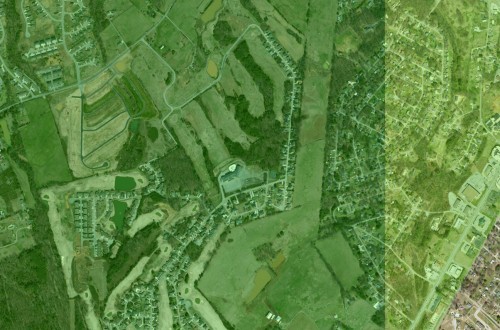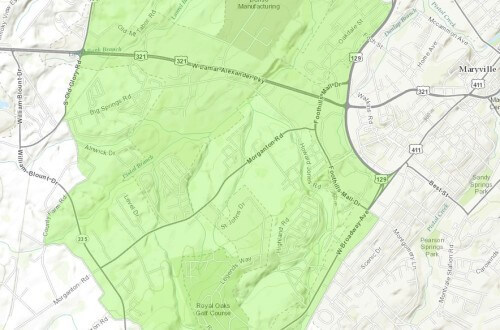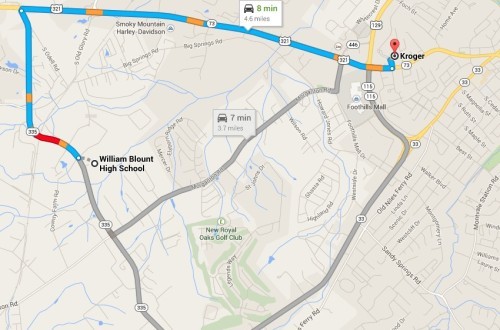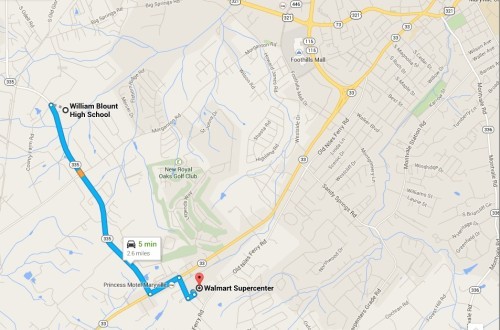Ricochet is the best place on the internet to discuss the issues of the day, either through commenting on posts or writing your own for our active and dynamic community in a fully moderated environment. In addition, the Ricochet Audio Network offers over 50 original podcasts with new episodes released every day.
 The Mirages In Your Local Food Desert
The Mirages In Your Local Food Desert
 James Lileks’ Bleat this morning got me thinking about this “food desert” idea that the First Lady has been talking about. Instapundit had a funny comment about grocery shopping in his local Federally-designated food desert the other day, which was the first I’d heard of the USDA’s interactive map of our produce-free arid zones. Well, I decided to check out the local food deserts for myself. Looking first in my home county (Blount County, Tennessee), I was shocked to find a giant food desert right at the doorstep of my church! In fact, our old sanctuary building is inside the desert, although the new one across the street has escaped this lack of privilege. If you look at the first satellite map, the green region is our food desert. What are the red circles I’ve added, you’re wondering? Don’t get ahead of me, now.
James Lileks’ Bleat this morning got me thinking about this “food desert” idea that the First Lady has been talking about. Instapundit had a funny comment about grocery shopping in his local Federally-designated food desert the other day, which was the first I’d heard of the USDA’s interactive map of our produce-free arid zones. Well, I decided to check out the local food deserts for myself. Looking first in my home county (Blount County, Tennessee), I was shocked to find a giant food desert right at the doorstep of my church! In fact, our old sanctuary building is inside the desert, although the new one across the street has escaped this lack of privilege. If you look at the first satellite map, the green region is our food desert. What are the red circles I’ve added, you’re wondering? Don’t get ahead of me, now.
The definition of a food desert on the USDA map is a census zone with both Low Income (“LI”) and Low Access (“LA”) to nutritious food. Now, the trick with a survey of this type is how these things are defined:
- Low Income is a tract with either a poverty rate ≥20%, or a median family income <80% of the state or region’s.
- Low Access is a tract in which either ≥500 people or 1/3 of the population live too far from a supermarket. Too far is different for urban and rural areas: >1 mi. for urban and >10 mi. for rural.
OK, with that in mind, let’s look at Blount County’s desert of shame. Remember the red circles I drew? Those are grocery stores. The one just outside the east end is Kroger’s, but it’s outside the desert, so maybe it doesn’t count. The other one is a Wal-Mart Superstore, and it’s inside the desert. So how does this area classify as Low Access? Ahh, but this tract is classified as “urban.” Let’s take a closer look at the denser portion of it, near the southern end.

Does that look urban? Don’t laugh — next to the farm there is a dense clustering of houses surrounding the golf course! Now, as a farm boy, I find all of this is too urban for me, but I doubt it would strike most people that way.
Since it’s “urban” and “low-income” (The golf course community isn’t the only neighborhood here—there are some poorer spots here and there), there must be a “supermarket” within one mile. So why isn’t there a gap a mile wide around each of the grocery stores here? Because the USDA is measuring the distances from the “centroid” (think center-of-gravity) of the census tract. Since that is farther than one mile from the stores, the whole tract is counted as too far from a store.
Here is another reason the approach doesn’t make sense to me: Why are there different distance criteria for “urban” and “rural” zones? If a country boy like me has “access” to a store within 10 miles, why is a city slicker restricted to traveling only one mile? I suspect it comes from the truly urban mindset that you don’t use a car to get anywhere and that a mile is as far as you care to walk.
But is that reasonable? Look again at this “urban” zone. Where do you think you’ll get on foot? To work? To school? Church? Everybody has a car. I looked up the statistics with the same USDA map: there are 7,915 people in this tract, grouped into 3,238 “housing units.” Of these, 51 housing units have no “vehicle access.” That’s 1.6% of the houses without “access” to a car. We don’t have buses here, and those few without vehicle access aren’t going to get anywhere by walking, so somebody has to give them a ride to get to work or school unless they’re an elderly shut-in who rarely leaves the house. In that case, I guarantee someone is helping bring groceries too. It’s not like these people are able to walk to a 7-11 and stock up on Cheetos. They’re being driven to get food.
Now that we’ve established that nearly everybody has a car — and even more have access to a car — how hard are those grocery stores to get to?
Here is an overview of the streets. William Blount High School, in the far western edge, is the most remote part of the tract.

If you want to go to Kroger, Google Maps says it’s 3.7 miles away and will take you 7 minutes.

Or, if you decide that’s too awfully hard for you to access, you can just go to Wal-Mart, which will take you…5 minutes to drive the 2.6 miles.

Whoop-tee-do.
Here’s my take on the whole project:
- The distinction between “urban” and “rural” is pointless. If people truly don’t have access to cars or buses, do they walk everywhere? Those are the only people for whom a neighborhood grocery store is necessary. This study blatantly ignores the rate of car ownership.
- If people have cars, look at the driving time, not the distance. My family drove halfway across the county to go grocery shopping. Even starting in town, you get to a bigger road and can go pretty far in just a few minutes.
- The use of census tracts and their centroids is crude. It makes you do dumb things like draw a food desert with a grocery store in it. I’m sure this made it easier for them to do the study, but their results don’t match their claims.





Oh, right! In fact, now I remember that it was your Bleat this morning that actually got me scratching my head about it today, and then I went back and reread Instapundit’s post. Let me correct the story [done].
Your discovery of the airport in the middle of the food desert seems to mirror the mall and industrial park in the middle of mine. Maybe this is a pattern with the “deserts.”
P.S: The Bleat is always my first read of the morning, over coffee.
P.P.S: Thank-you to whichever editor cleaned up my post. I appreciate both the image-fixing and the grammar.
Now, this brings up an important point. We’ve occasionally criticized the “food desert” concept for ignoring sources of food like convenience stores. But that’s part of their intention. The Wikipedia entry on “Food Deserts” gives a variety of definitions, but one that it quotes directly uses “urban areas with 10 or fewer (grocery) stores and no stores with more than 20 employees.” Why the bias against smaller grocery stores (and 20 isn’t that small)?
Well, according to the article on “Supermarket Shortages,” the idea is that smaller, neighborhood grocery stores tend to offer less variety of foods, as well as less choice of healthy foods. That’s certainly possible, but does that mean that the customers of smaller stores aren’t able to buy a good selection of healthy foods there? No. I mentioned Pittsburgh’s Strip District, above. It’s renowned for its variety and quantity of produce (there are both wholesalers and retailers there), and I bet that few of its stores have as many as 20 employees. [cont’d]
[cont’d] Farmer’s markets and produce stands would be excluded by this standard, as well, despite them selling only the stuff the food-desert advocates (wait…that came out wrong) want. Pittsburgh has a food desert in the Oakland neighborhood, near the University of Pittsburgh campus, where I went to grad school. It’s definitely an urban zone, but there’s a pretty good grocery store right inside the desert. (The link goes to their website.) It’s got a nice selection of meats and produce, in addition to canned goods and whatever else you’d want. I bet there aren’t five people working there at one time. So why discount it, based on the number of employees?
Because it’s easier that way. Making a map of the whole United States and people’s incomes and shopping opportunities is hard work. Many of things the rest of you and I are criticizing them for are things they did to save time and effort. Is that unfair of us? [dramatic pause…]
The grocery stores that exist within the “food deserts” around here have plenty of fresh produce.
But maybe not arugula.
No. Yes, I’m sure they worked hard on it, and yes, I’m sure it would have taken them forever to change the problems we’re talking about. But it’s the results that matter.
Their methodology has produced shoddy results. Laughable results. The best they can claim is that they’ve got a crude survey that can be used to identify areas for a more careful follow-up study.
That’s the kind of thing we do in astronomy all of the time. It’s hard to measure some of the things we’re interested in about galaxies, say. Maybe you want to know how massive their central black holes are. Measuring this is hard work, but you have other things that correlate with their masses: how bright the galaxy is, how fast it rotates, how bright the x-rays or radio signals are from the galaxy center, and so on. If you want to identify the galaxies with the most massive black holes, you might use these proxies to narrow down your search, but you should follow up with a careful measurement later and not claim you’ve already got the answer.
Tim, thanks for leading the discussion. This shoddy research can also be viewed as an artifact of using GIS-powered databases in the social sciences without thinking through how the results don’t really make much sense. The ease with which geo-coded census tracts can be tied to layers and layers of underlying demographic and economic data can lead to lousy studies and even lousier public policy.
And toss money at it.
Michelle Obama’s multi-billion-dollar campaign to revolutionize the inner city diet by bringing healthier foods to low-income neighborhoods is failing miserably, according to a new study, . . .
The goal is to eliminate “food deserts,” common in poor, minority communities where fresh, healthy food is tough to find or often unavailable. . . . As part of a $4.5 billion law (Healthy, Hunger-Free Kids Act) pushed through by the First Lady the government commits hundreds of millions of dollars annually to bring whole foods . . . to underserved neighborhoods nationwide.
In the last few years the administration has dedicated huge sums to eradicate food deserts. This includes $75 million to study ways of better recognizing the nutritional needs of low-income communities and more than $100 million in Obamacare grants to “reduce health disparities” between minorities and whites by, among other things, eliminating food deserts.
Check out that last line. Food deserts are racist.
I checked out my town of Santa Rosa, CA. I thankfully don’t live in a food desert. I did discover, however, that I do most of my grocery shopping in a food desert. One of the food deserts in my town contains the Trader Joe’s, Costco, Cash and Carry, Smart and Final, Lulus Mexican Market, Phnom Penh Asian Market, Santa Rosa Seafood, Laotian Asian Market and Target that get about 70% of my food dollars. The other food desert has a Safeway .4 miles on one side and another .4 miles on the other and about 300 yards from the edge is a full sized gourmet grocery store (that get most of the rest of my food money). I shudder to think of the wasted lives and money on this project……….A fake problem, fake research and a useless website.
This is wonderful. Some of the best journalism I’ve seen on Ricochet in a while. Lilek’s airport hit is somewhat powerful, but nowhere near as cutting as the point that you can be standing in the middle of a produce section of a major supermarket and have the government concerned that you’re insufficiently close to a supermarket.
I shall reference this widely.
You’re welcome, Big John! Your comment about the GIS-powered databases is insightful. For those who aren’t familiar, GIS means “Geographic Information System,” which covers a lot of territory (hey, an unintentional joke!), but a lot of it involves the ability to plot different kinds of information on a map: terrain, rainfall, population, forest cover, census data, and so on.
It is a wonderful tool, and now that we have large databses of information available on the internet, it is fairly easy to do a big, nationwide study of this kind. But the ease of use can make us get carried away. We still have to understand the meaning of what we’re doing, which is something this study missed.
More later, with another astronomy comparison…
The nearest food desert for me? Winter Park, Florida. $$$$$
Median income about $76,000/year, median home price over $300,000.
Most specifically, Rollins College (also $$$$$), with the high-dollar shopping center just north.
There are low-income neighborhoods nearby – right next to stores like Publix.
There’s also a hilarious one in south Orlando, surrounding the Florida Mall (and a Target), with a Sam’s Club and an Aldi supermarket. The area is mostly suburban-style, houses-only neighborhoods right next to an industrial/shopping district. It’s literally impossible, by the way, to be more than a mile from an actual grocery store in this area…
Tim, if it wasn’t for your thread I never would have known that, while eating my apple, cranberry, walnut salad at the Schenley Cafe across the street from the Farmer’s Market at the Phipps Conservatory (held weekly outside the award winning Phipps Cafe) just down the street from the IGA grocery store you mentioned earlier, that I was in a food desert.
Thank you from saving me from starvation!
If this discussion hasn’t been shared on the Ricochet Facebook page, it should be and soon!
Excellent writeup Tim!
Heh, in my town the biggest desert is right by the town’s busiest/biggest grocery store.
Also the college campus, which has free bus routes to that big grocery store for students without cars.
Also the airport is a food desert.
Most of Southern Utah counts as a food desert. Maybe because…it’s an actual [CoC] desert.
But closer to home, we’ve got one that overlaps the Great Salt Lake, and surrounding duck-hunting marshes, and another that’s halfway over a federally designated wilderness area.
Again, Tim, let me thank you for posting this.
I demand that a grocery store be built in my Food Desert. There is actually a grocery store about a mile from me, but I live on a high hill about 500 feet above the highway. Walking down that hill is no problem, getting back up, with an armload of groceries would leave me starving to death, especially in winter. Also in the Flathead the criteria is 1/2 mile not a mile, and some of that covers the John Marshall Wilderness.
Checking South County Rhode Island, an area with which I am very familiar. One “desert encompasses some of the priciest waterfront homes in the state. I wonder if the high percentage of summer/seasonal homes (often occupied in winter by students at the University of Rhode Island) skew the income averages.
The other desert is, you guessed it, the University of Rhode Island.
Ugh. One of the real blessings of living NOW is the fact that our diets are not limited to local food. It’s wonderful to be able to eat fresh citrus and strawberries in winter. To have spices from around the world. Fresh lamb from New Zealand. etc etc etc. I would sentence those morons to a diet of local cabbage all winter, no pepper or spices and no imported beer wine or spirits.
Oh snap! I just learned that about 75% of the county I live in is a food desert. Whatever shall I do?
This food desert thing wouldn’t be such a problem if only someone could invent some sort of home refrigeration unit, so that a person didn’t have to go to the grocery store every day for their perishables.
You know, pigs can really be surprisingly fast.
I want to caption this one, “Yes, you’re my little slow dinner. Yes, you are, cutie pie!”
Wow…I grew up in an area where some of us had to travel about 35 miles to get to a grocery store. Or…we could (in summer) go to the garden and get fresh produce. Or…(in winter) go down to the basement and get a jar of home canned green beans for dinner. Or…go out to the barn and get a gallon of milk from a cow. Or…go to the chicken coop and pick up a couple of eggs from a nest. We had a plant-based diet—it’s just that we cycled the plants through a pig or a steer, first. Many of my relatives still live in these horrible conditions. It’s a shame.
Holy Shnikies! It appears my parents and grandparents live in a food desert. I never knew they had it so rough. Whenever I go home we have to drive 5 min to get to the town’s largest grocery store which, apparently, is in the food desert too. Sometimes we even have to drive 7 min to get to the other grocery store outside the food desert, or 8 min to the butcher shop. My grandpa (when his health permitted) used to like to ride his 4-wheeler into town to go to the grocery store … in the food desert. If things get really tough, I suppose my family can walk out to their backyard and pick fruit from the trees, vegetables from the garden, or collect eggs from the chicken coop. Brutal.
Yeah, I noticed that about the county where I grew up. It features a gigantic “food desert” that encompasses two large towns and three small towns. (Each of which have two to three grocery stores, by the way.) I have no idea how those towns even exist inside of a food desert. Shouldn’t everyone have starved?
If you don’t already know you’re in a food desert because of the terrible inconvenience of grocery shopping, you’re not in a food desert, and it doesn’t matter what the USDA says.
Thanks for pointing this out,Big John. I’m a social scientist and I was trained that you don’t go off mining data without a theory or grounded research findings to guide your analyses and interpretation…or as my favorite professor would say “looking at lots of data for lots of time can lead to lots of mistakes.”
I’m afraid I can’t live up to the amusing form of the other comments, here. But, the observations hold true for my town, and demonstrate government bureaucrats with too much time on their hands.
According to the USDA map, our house isn’t in a “food desert” (I suspect the income level is higher than the USDA threshold. But, the supermarket we use (3 miles from our house) is in a “food desert” that includes most of the town center. The supermarket is at the far west end of the “desert.” Many older people live in the center of the town (may have low incomes, but generally aren’t lacking for access to resources). There is a low income apartment complex at the east end of the “desert.” But, many of the residents in the apartment complex are of an ethnic group that does a lot of communal car transportation (always 4 or 5 of them in a car), so I suspect those without a car can find a neighbor with one to take them to the store. Plus, a new “corner store” just opened near the apartment complex that carries vegetables specifically tailored for that ethnic group.
My brother lives within the city limits of Camden, New Jersey. He drives outside of Camden to do his grocery shopping. Who would want to walk to buy their groceries in Camden? That’s one of the reasons why I help pay for the upkeep of his car while he is marginally employed. It preserves life.
If any place qualified as a food desert, it probably would be Camden, NJ.
Not only that, but 15,000,000,000 hardworking middle-class Americans in the food deserts have no health care. At all. Nothing. ¡Nada! Ixnay on the andbay aiday. They’re going to die before they starve to death.
Much harder to program in “driving time”– they might be able to use “distance to bus line with grocery store on it” without their computers melting, though. Any groceries you can walk a mile packing would be just as easy to get on a bus.